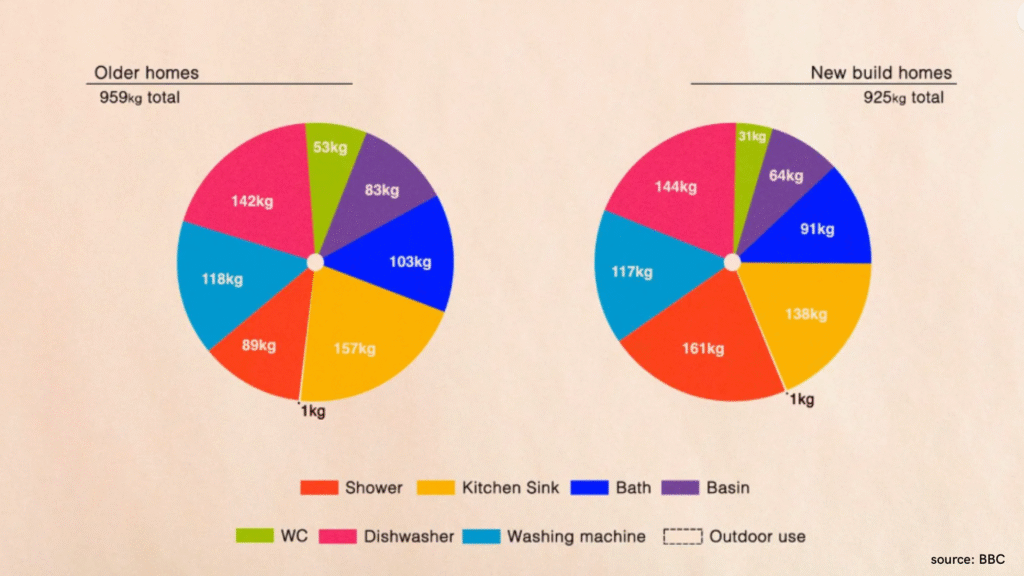The energy price cap rose to £1,849 a year for a typical UK household paying by Direct Debit, at the start of April this year. This is a 6.4% increase from the previous cap set for January to March 2025.
While space heating remains the biggest contributor to overall energy use for homeowners and tenants, it’s worth considering that around 12% of a ‘gas-heated household’s energy bill’ is due to water heating for showers, baths and hot water from taps. Also, unlike space heating, hot water is needed all year round. So the costs add up, and for specifiers designing energy- and cost-efficient homes, it’s a year-round load that must be accounted for while designing buildings.
We understand that energy efficient electric heating, smarter consumption patterns to maximise cheaper off-peak tariff and policy cost rebalancing to lower electricity prices are all key, future-focused pathways to keep energy bills in check. But let’s look at how important it is to rethink domestic hot water systems for buildings so as to choose the right thermal storage technology, especially as electrified home heating becomes the legal standard for new builds under the proposed future homes standard (FHS).
Are you aware of the impact of domestic hot water consumption on the environment?
Did you know water heating contributes to 5% of UK’s total CO2 emissions?
On average, every household in the UK uses around 345 litres of water each day – that’s 145 litres per head, every day. Saving water saves energy – the energy required to filter, heat, treat and pump water to our homes. We now use almost 50% more water than 25 years ago. Domestic water consumption, then, leaves a significant carbon footprint. This is critical to know as home developers, specifiers and architects must consider decarbonised domestic hot water systems as a part of their low-carbon building design. To comply with the proposed FHS means calculating carbon savings beyond space heating, and water heating is often overlooked in the early-stage design.

Source: The hidden impact of your daily water use, BBC
Thus, there are significant savings to be made by selecting the right hot water system with the low-carbon space heating source.
The impact of water heating on energy costs
As mentioned before, heating water accounts for 12% of an average UK’s household’s energy bill, which is also about 25% of the fuel a gas boiler consumes.
Typically, households heat water using their central heating, for instance a system boiler, while storing and heating a specific amount of water in a hot water tank or cylinder. Another option used is immersion heaters, which are essentially electric water heaters immersed in an insulated hot water cylinder. But the most common preference – about 78% of UK households – is gas boilers for heating water (80% of which are combi) as these are thought to be convenient for instant hot water delivery.
And while the gas boiler ban by 2035 was revoked earlier this year, the last briefing on the oncoming future homes standard (FHS) precludes the installation of gas boilers in new build homes. Gas boiler emissions in the UK homes emit twice as much CO2 and eight times NO2 as all of UK’s gas-fired power stations combined, and more CO2 emissions in a year than a person taking seven transatlantic flights.
So as heat pumps become the go-to heating solution for new developments, choosing the water heating technology becomes a key variable in electrifying homes and ensuring compliance.
Let’s make a quick comparison between the thermal storage technologies: how water cylinders vs Sunamp’s thermal store, Thermino heat battery
Space considerations:
Space is precious in the UK. On average, the cost per sq. ft. of space in England is £366.
Thanks to the highly energy dense phase change material used in a Thermino heat battery, it is about four times smaller than an equivalent hot water tank.
So, if you were to replace or retrofit an existing hot water cylinder in a cupboard with a Thermino battery, you would save about 2 sq. ft. of space, whereas if you are installing the Thermino battery in a new build or retrofitting it in a way that allows you to position it under the stairs or in a crawl space, effectively eliminating the need for a cylinder cupboard, you would save around 6 sq. ft. of space. These floor and cupboard space savings unlock new flexibility in layout designing, as well as enhance aesthetics of your dwellings, which is key in designing modern and contemporary homes.

Using a heat battery as your hot water system helps overcome the key barrier in installing heat pumps in smaller homes.
This is particularly true for social housing apartments which often lack space for a bulky hot water cylinder.
Take a look at how our heat batteries were retrofitted in space-constrained council flats in Sunderland and Thurrock, enabling renewables’ installation.
Maintenance & cleaning:
According to Health and safety executive (HSG 274 Part 2), annual water tank inspections are a legal requirement, and tank cleaning needs to be carried out every 3 years – costing residents/landlords anywhere between £200-£500 for 110-500L tanks.
A Thermino heat battery requires no mandatory maintenance – only routine upkeep of external plumbing components.
Daily standing heat loss:
You could lose between 1.4 kWh and 3.34 kWh in daily standing heat losses with a hot water cylinder (whether vented copper or direct unvented); the energy costs from these losses add up at an annual basis, and can be significant – whether the heat source is gas or electric. In comparison, the heat losses with a Thermino battery are about 0.67-0.87 kWh/24h, almost 50-75% lower. Reduced heat loss directly support SAP performance targets.
Performance:
Sunamp’s patented Plentigrade PCM technology ensures delivery of instant mains pressure hot water on showers and taps, which meets a new build buyer’s expectations of comfort, which is increasingly important to enhance the appeal of your housing stock.
Carbon savings:
Thermino xPlus helps with pre-heating hot water in a combi; preheating (where the boiler fires up every 30-90 mins) is necessary for instant hot water, but an untimed preheat takes up 500-750 kWh annually. When paired with a system boiler, the heat battery helps cut the amount of gas consumed significantly.
Also, Thermino ePlus or xPlus heat batteries will maximise the use of free-PV-generated electricity to provide instant hot water, and when paired with off-peak electricity, the energy bills are lowered further.
Thermino xPlus can be paired with heat pumps + solar PV and effectively bring down the onsite carbon emissions to zero – reducing both operational and embodied carbon of your projects – which is increasingly important as new build homes go gas-free and all-electric.
Click here to schedule a consultation. Speak to us to know more about our projects where our ePlus or xPlus range of Thermino heat batteries have helped architects, energy consultants, engineers and housing associations in meeting the latest building regulation standards.
Thermino heat batteries can be manually entered in SAP 10.2 software to help you model dwelling energy performance. Click here to know more.
